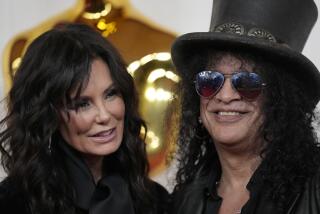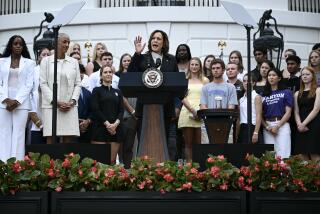Art Deco Mecca
Scholars may split hairs on what constitutes Art Deco, the exuberant style of design and architecture that flourished between the world wars.
But Mitzi March Mogul, president of the Art Deco Society of Los Angeles, cites a simple reason for the movement’s continuing allure more than half a century later. “It’s really about ‘ain’t we got fun.’ That really does say it all,” she said.
And that helps to explain why 200 people, architecture fans from as far away as Australia, South Africa and Rhode Island, traveled to downtown Los Angeles for Thursday’s opening of the World Congress on Art Deco at the Biltmore Hotel.
The conventioneers heard lectures on how Hollywood movies in the 1920s and ‘30s influenced the design of passenger trains, nightclubs and kitchen toasters around the world. Actress Fay Wray, 89 and astonishingly fit, recalled how King Kong carried her to the terraced top of that Art Deco icon, the Empire State Building (albeit a studio model in the 1933 film.)
Yet most compelling, delegates say, is the chance to tour such Art Deco landmarks of Southern California as the Argyle Hotel on the Sunset Strip, the Wiltern Theatre, the Queen Mary, Los Angeles City Hall, the Eastern-Columbia building downtown, the former MGM Studios (now owned by Sony) and the Bullock’s Wilshire department store that recently was turned into a law school library.
The visitors’ passion should persuade local civic leaders and developers that architectural preservation makes good business and tourism sense, said Mogul, chief organizer of the five-day convention. “People will come for this,” she said. “They are not coming here to go to Disneyland. They are not coming to go to the beach or mega-malls.”
Delegates say they love the sleek geometric patterns and striking colors that pushed aside Victorian fussiness for Jazz Age fascination with machinery and speed. They adore chrome elevator doors stamped with sunburst images and tiled bathrooms that make them feel as if they wandered into a Fred Astaire movie. They want to see the Coca-Cola bottling plant that resembles a streamlined cruise ship and the Wilshire Boulevard office buildings that mimic Assyrian temples or Buck Rogers rocket ships.
Art Deco reminds people of imagined cocktail parties during the flapper era and of escapist fantasies from the Great Depression--curbside relief along the grim city streets of the 1990s.
Carol Paterson, a congress attendee from Sydney, Australia, said that she has been “knocked out” by what she has seen so far. “Los Angeles is one of the greatest Art Deco cities on the face of God’s earth. And there is not enough, it seems to me, preservation of these magnificent buildings. There should be a whole industry of bringing tourists here on the basis of Art Deco.”
*
On the East Coast, the current image of Los Angeles is often defined by news reports of gang violence, according to Joan MacDonald of Watertown, Mass. The Deco convention, she said, “is a great opportunity to come and see what is good about L.A.”
Held every two years, this is the fourth World Congress on Art Deco and the first on the West Coast. Previous ones took place in Australia, Great Britain and in Miami, where the restoration of once-seedy Art Deco hotels has made South Beach hip and profitable.
Los Angeles activists hope the same might happen on Wilshire Boulevard’s Miracle Mile. That’s where the 14-year-old local Deco Society has its office in the circa-1930 Dominguez Wilshire building, now undergoing a restoration. Nearby are such other Deco gems as the Desmond’s store building and the El Rey Theater.
Buildings like that helped turn Los Angeles into a cosmopolitan city, Mogul said. And in a hall-of-mirrors effect, Hollywood set and clothes designers copied and influenced what appeared outside studio gates. “The style fit the exuberant qualities of Los Angeles, because this has always been a city that encourages eccentricity and ‘do your own thing,’ ” said Mogul, 40, who is a self-taught architectural historian and lives in a 1908 bungalow in the West Adams district.
The term “Art Deco” derives from a 1925 exhibit in Paris called the Exposition Internationale des Arts Decoratifs et Industriels Modernes. To be sure, Art Deco is a catch-all term that some experts complain has been extended wrongly to many styles, such as Streamline, Moderne, Zigzag and Classical revivals. That tension arose briefly Thursday when Robert Winter, co-author of architectural guidebooks to Los Angeles, was good-naturedly booed by the audience for making such distinctions during a lecture.
In the 1994 book “Art Deco,” author Richard Striner noted that Art Deco is really a cluster of fashions “derived from sources as diverse as classical antiquity and futuristic fantasy. It used exotic ornamentation while assimilating streamlined industrial design.” The conventioneers say they know it when they see it.
Yet seeing it in the Los Angeles area requires “tunnel vision,” said Roderick Gradidge, a British architect attending the congress. For example, he attended a reception Wednesday night at the Argyle Hotel, which reminded him of his childhood fantasies of Hollywood luxury. But driving to the Sunset Strip from downtown displayed “miles and miles of visual squalor,” he said.
After World War II, Art Deco was swept aside by unornamented Modernist architecture. In Los Angeles, nothing demonstrated that better than the 1969 demolition of the Richfield Oil building at Flower and 6th streets. That beloved black-and-gold structure of setbacks and elaborate friezes was replaced by the austere twin Arco Towers.
In another loss, the neglected Pan-Pacific Auditorium near Beverly Boulevard was destroyed in a suspected arson fire in 1989. Images of its fin-like pylons still are used on brochures for the Art Deco Society of Los Angeles.
*
Art Deco returned to vogue in the 1960s, partly as kitschy nostalgia and partly because its outrageousness appealed to psychedelic sensibilities of the time, fans concede. It now gets serious academic respect. And while many Art Deco buildings in Los Angeles are in disrepair, restoration successes since the 1980s include the Argyle and the Wiltern and Pantages theaters.
Dietrich Neumann, an architectural historian from Brown University who is a lecturer at the congress, agreed that the Deco label is “fuzzy at the edges.” But Deco buildings, constructed when labor was cheaper and craftsmanship high, all share detailing and an urban flavor that is lacking in much of modern and suburban architecture, he said. “I think we all want that back,” he added.
Mogul insists that studying the Art Deco era, its politics as well as its fashions, helps people live in the present: “It helps me understand that things don’t happen in a vacuum, that what happens today is because of something that happened yesterday and the day before and the day before that.”
Fitting its theme “L.A., Art Deco and the Movies,” the congress is sponsoring a showing of the 1930 Cecil B. DeMille film “Madame Satan” at 7:30 tonight at the historic State Theater, Broadway and 7th Street. The public can purchase tickets for $8.
The congress’ tours are sold out. Tickets for lectures at the Biltmore’s Gold Room are available for morning sessions today and Monday, starting at 9 a.m., for $5; from 9 a.m. to 3 p.m. Saturday for $7.
More to Read
The biggest entertainment stories
Get our big stories about Hollywood, film, television, music, arts, culture and more right in your inbox as soon as they publish.
You may occasionally receive promotional content from the Los Angeles Times.







